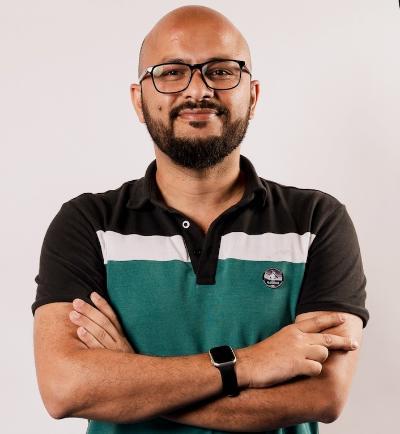Introducing Professor Qammer Abbasi
Tell us about yourself
My journey into applied electromagnetics and sensing began with a BSc and MSc in electronics and telecommunication engineering from UET Lahore, Pakistan, leading to a PhD at Queen Mary University of London, where I specialised in advanced electromagnetics and antenna and propagation design for body-centric wireless communication. I joined the James Watt School of Engineering, University of Glasgow, in 2017 as a Lecturer, where I currently serve as a Professor of Applied Electromagnetics & Sensing.
I have the privilege of leading a dynamic team of researchers as part of the Communication, Sensing and Imaging Hub, where I am Co-Director. I also served as Deputy Theme Lead for Quantum Technologies in the Advanced Research Centre (ARC) and am currently acting as the Theme Lead for Connecting People at the James Watt School of Engineering. Additionally, I lead the design and integration efforts in the Centre for Advanced Electronics and am Co-Director for the EPSRC-funded CDT "Diversity-led, Mission-Driven Research”.
How would you describe your research interests and current work?
My research sits at the intersection of applied electromagnetics and Integrated Sensing & Communication (ISAC), with a focus on shaping the future of wireless networks as we move toward 6G. Imagine a world where your environment actively optimises communication and sensing through smart surfaces and devices—such as a home that not only has enhanced wireless coverage but also continuously monitors your health, predicts potential issues, and helps prevent illnesses.
A key technology in this vision is Reconfigurable Intelligent Surfaces (RIS), which dynamically control electromagnetic waves for improved signal strength and coverage while simultaneously monitoring health parameters, offering a seamless integration of communication and sensing.
In addition to advancements in future telecommunications, my work also involves developing nanoscale devices and wearable sensors that operate in the millimetre and terahertz frequency ranges, ideal for high-resolution imaging and precise health monitoring. For instance, my team is working on wearable devices that can detect early signs of diabetes-related complications or dehydration, using advanced optical sensors and artificial intelligence.
Another exciting area of my research involves creating nanoscale devices that operate at terahertz frequencies, capable of communicating within the human body to monitor and respond to health conditions at a cellular level.
Ultimately, my research aims to redefine the future of connected environments, where the seamless convergence of communication, sensing, and advanced electromagnetic technology not only enhances everyday life but also empowers individuals to take control of their health and well-being in ways that were once unimaginable.
What would you most like people to know about you?
I am deeply passionate about leveraging the power of applied electromagnetics and sensing to address real-world communication and health challenges. My work is driven by a commitment not just to advancing scientific knowledge in the field, but to creating practical, innovative solutions that connect the unconnected and make healthcare more accessible, effective, and proactive.
To achieve this, I believe in the transformative power of interdisciplinary collaboration. I strongly advocate for breaking down silos between fields, as I believe that the most innovative solutions often emerge at the intersection of diverse disciplines. Whether it’s working with experts in medicine, engineering, social sciences, or artificial intelligence, I am always eager to engage with professionals who bring different perspectives to the problem at hand. This collaborative approach not only enriches my research but also ensures that the solutions we develop are holistic and have a tangible impact on people's lives.
In essence, I want people to know that my work is fuelled by a genuine desire to make a difference. I am committed to driving forward innovations that do more than just advance science—they change lives for the better.
What do you like most about working in the ARC?
The Advanced Research Centre (ARC) at the University of Glasgow is more than just a research facility—it’s a dynamic and transformative environment where collaboration and creativity are at the heart of everything we do. The ARC’s mission to unite researchers from across disciplines, sectors, and industries aligns perfectly with my vision for innovation in applied electromagnetics and sensing. What truly excites me about working at the ARC is its commitment to fostering a free-thinking, ambitious research culture.
The ARC nurtures an inclusive and fearless scholarly community that encourages experimentation and the co-creation of new ideas—an ethos that is crucial for developing groundbreaking technologies with real societal impact. The seamless integration of diverse fields at the ARC not only fosters innovation but also enables the development of technologies with the potential to transform lives. The environment here accelerates the transition from lab research to real-world application, making the ARC not just a place of innovation but a catalyst for real change.
The ARC’s dedication to transparency, coordination across disciplines, and inclusive decision-making makes it an inspiring place to work. Here, the potential to transform lives through innovative research is not just a goal—it’s a reality.


